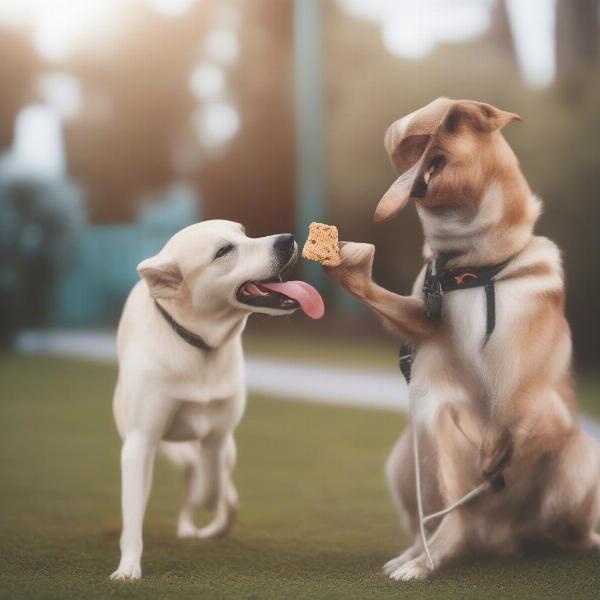Dog clamps, though not a common term in everyday dog care, can refer to a few different things depending on the context. This article aims to clarify the different meanings of “dog clamps” and provide valuable information related to each interpretation. We’ll explore their potential uses, associated risks, and safe alternatives for various dog-related scenarios.
What Does “Dog Clamp” Mean?
The term “dog clamp” can be confusing. It doesn’t refer to a single, universally recognized product. Instead, it can describe several different tools or situations:
- Grooming Clamps: In the grooming context, “dog clamps” might refer to clips used to section off a dog’s fur during grooming, or even specialized clamps used to temporarily stop bleeding from small cuts or nicks.
- Medical Clamps: Veterinarians use various clamps during surgery or medical procedures. These are highly specialized and not typically something a pet owner would use.
- Clamping Down (Behavioral): Sometimes, people use “clamp down” metaphorically to describe a stricter approach to dog training or behavior modification. This doesn’t involve physical clamping but rather enforcing rules and boundaries more rigidly.
- Improvised Clamps: Unfortunately, some people might misuse tools like C-clamps or other hardware as makeshift restraints or muzzles. This is highly dangerous and should never be done.
Safe and Effective Alternatives to Improvised Clamps
Using tools not designed for dogs can cause serious injury and distress. Here are safer alternatives depending on the intended use:
- For Grooming: Use professional-grade grooming clips designed specifically for dogs. These are safe and effective for sectioning fur and controlling stray hairs during grooming.
- For Restraint: If you need to restrain your dog for medical procedures or grooming, consult with a veterinarian or professional groomer. They can demonstrate safe and humane restraint techniques. Consider investing in a properly fitted muzzle for situations where biting is a concern.
- For Behavior Modification: Focus on positive reinforcement training methods that reward desired behaviors. Consult with a certified dog trainer or behaviorist for guidance on addressing specific behavioral issues.
Dog Grooming with Clamps: A Closer Look
Grooming clamps, as mentioned earlier, are used to section a dog’s coat during grooming. This makes the process more manageable, especially for dogs with long or thick fur. They can also be helpful for keeping hair out of the dog’s eyes while trimming around the face.
It’s important to choose grooming clips that are appropriate for your dog’s coat type and size. Avoid using clips that are too tight or could pull on the dog’s skin. Always supervise your dog while using grooming clips.
Addressing Behavioral “Clamping Down”
When discussing behavior, “clamping down” often means establishing clearer rules and boundaries for your dog. This isn’t about being harsh but about providing consistent guidance. This might involve:
- Consistent Training: Reinforce basic commands and good behavior regularly.
- Managing the Environment: Prevent your dog from accessing areas where they tend to misbehave.
- Addressing Underlying Issues: Identify any triggers or anxieties that might be contributing to unwanted behavior.
 Dog Training with Positive Reinforcement
Dog Training with Positive Reinforcement
Conclusion
While the term “dog clamps” can be ambiguous, understanding its various interpretations is key to providing proper care for your dog. Remember to prioritize your dog’s safety and well-being by choosing appropriate tools and methods for grooming, restraint, and behavior modification. Avoid using improvised or unsafe devices, and always consult with professionals when necessary.
FAQs
-
What are dog grooming clamps used for? Dog grooming clamps are primarily used to section the dog’s fur during grooming, making the process easier and more efficient.
-
Is it safe to use household clamps on a dog? No, absolutely not. Using household clamps on a dog is extremely dangerous and can cause serious injury.
-
What should I do if my dog needs to be restrained? Consult a veterinarian or professional groomer for guidance on safe and humane restraint techniques.
-
What is the best way to address behavioral problems in dogs? Positive reinforcement training and addressing underlying issues are the most effective methods for behavior modification.
-
Where can I find safe and appropriate grooming tools for my dog? Pet supply stores and online retailers offer a wide range of dog grooming tools.
-
How can I find a qualified dog trainer or behaviorist? Your veterinarian can often recommend certified dog trainers or behaviorists in your area. You can also check online directories.
-
What should I do if my dog gets a small cut during grooming? Apply gentle pressure to the wound with a clean cloth. If the bleeding persists, contact your veterinarian.
Related Articles
About ILM Dog
ILM Dog is your trusted resource for expert advice and information on all aspects of dog care and ownership. We offer practical guidance on everything from breed selection and puppy care to senior dog health and training. At ILM Dog, we’re passionate about helping dog owners provide the best possible care for their canine companions. Our expertise encompasses a wide array of topics including breed selection, health and medical care, training, nutrition, grooming, and appropriate accessories. Contact us today to learn more! Email: [email protected], Phone: +44 20-3965-8624. Visit us online at ILM Dog for more helpful tips and resources.